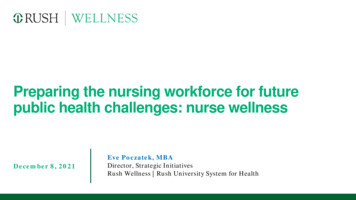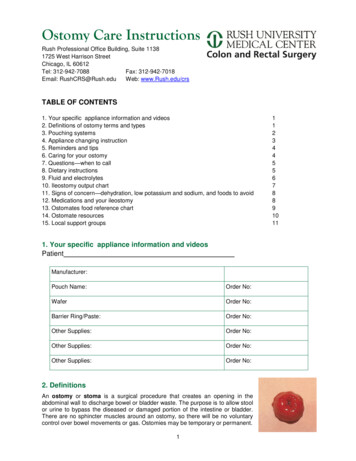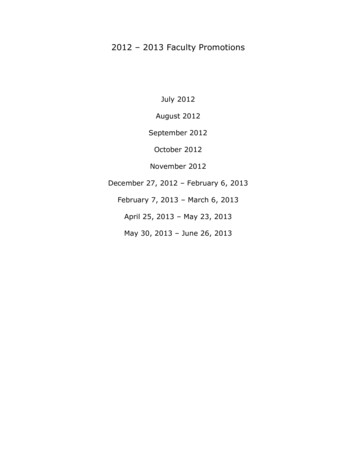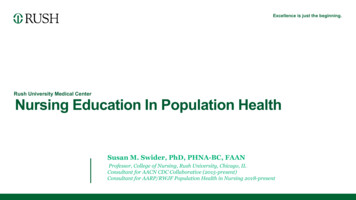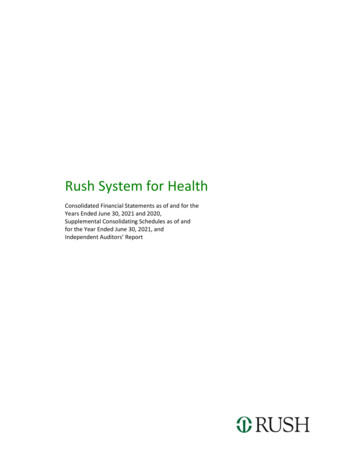
Transcription
Rush System for HealthConsolidated Financial Statements as of and for theYears Ended June 30, 2021 and 2020,Supplemental Consolidating Schedules as of andfor the Year Ended June 30, 2021, andIndependent Auditors’ Report
RUSH SYSTEM FOR HEALTHTABLE OF CONTENTSPageINDEPENDENT AUDITORS’ REPORT1-2CONSOLIDATED FINANCIAL STATEMENTS AS OF AND FOR THE YEARS ENDED JUNE 30, 2021 AND 2020:Balance SheetsStatements of Operations and Changes in Net AssetsStatements of Cash FlowsNotes to Consolidated Financial StatementsSUPPLEMENTAL CONSOLIDATING SCHEDULES AS OF AND FOR THE YEAR ENDED JUNE 30, 2021:Consolidating Balance SheetConsolidating Statement of Operations and Changes in Net Assets34-567-43444546-47
INDEPENDENT AUDITORS’ REPORTTo the Board of Trustees ofRush System for Health:We have audited the accompanying consolidated financial statements of Rush System for Health and itssubsidiaries (the “System”), which comprise the consolidated balance sheets as of June 30, 2021 and2020, and the related consolidated statements of operations, changes in net assets, and cash flows forthe years then ended, and the related notes to the consolidated financial statements.Management’s Responsibility for the Consolidated Financial StatementsManagement is responsible for the preparation and fair presentation of these consolidated financialstatements in accordance with accounting principles generally accepted in the United States of America;this includes the design, implementation, and maintenance of internal control relevant to thepreparation and fair presentation of consolidated financial statements that are free from materialmisstatement, whether due to fraud or error.Auditors’ ResponsibilityOur responsibility is to express an opinion on these consolidated financial statements based on ouraudits. We conducted our audits in accordance with auditing standards generally accepted in the UnitedStates of America. Those standards require that we plan and perform the audit to obtain reasonableassurance about whether the consolidated financial statements are free from material misstatement.An audit involves performing procedures to obtain audit evidence about the amounts and disclosures inthe consolidated financial statements. The procedures selected depend on the auditor’s judgment,including the assessment of the risks of material misstatement of the consolidated financial statements,whether due to fraud or error. In making those risk assessments, the auditor considers internal controlrelevant to the System’s preparation and fair presentation of the consolidated financial statements inorder to design audit procedures that are appropriate in the circumstances, but not for the purpose ofexpressing an opinion on the effectiveness of the System’s internal control. Accordingly, we express nosuch opinion. An audit also includes evaluating the appropriateness of accounting policies used and thereasonableness of significant accounting estimates made by management, as well as evaluating theoverall presentation of the consolidated financial statements.We believe that the audit evidence we have obtained is sufficient and appropriate to provide a basis forour audit opinion.OpinionIn our opinion, the consolidated financial statements referred to above present fairly, in all materialrespects, the consolidated financial position of Rush System for Health and its subsidiaries as of June 30,2021 and 2020, and the results of their operations and their cash flows for the years then ended inaccordance with accounting principles generally accepted in the United States of America.
Report on Consolidating SchedulesOur audits were conducted for the purpose of forming an opinion on the consolidated financialstatements as a whole. The consolidating schedules on pages 45‐47 are presented for the purpose ofadditional analysis of the consolidated financial statements rather than to present the financial position,results of operations, and cash flows of the individual companies, and are not a required part of theconsolidated financial statements. These schedules are the responsibility of the System’s managementand were derived from and relate directly to the underlying accounting and other records used toprepare the consolidated financial statements. Such schedules have been subjected to the auditingprocedures applied in our audits of the consolidated financial statements and certain additionalprocedures, including comparing and reconciling such schedules directly to the underlying accountingand other records used to prepare the consolidated financial statements or to the consolidated financialstatements themselves, and other additional procedures in accordance with auditing standardsgenerally accepted in the United States of America. In our opinion, such schedules are fairly stated in allmaterial respects in relation to the consolidated financial statements as a whole.October 28, 2021‐2‐
RUSH SYSTEM FOR HEALTHCONSOLIDATED BALANCE SHEETS(Dollars in thousands)As of June 30,20212020ASSETSCURRENT ASSETS:Cash and cash equivalentsAccounts receivable for patient servicesOther accounts receivableSelf‐insurance trust—current portionOther current assets Total current assetsASSETS LIMITED AS TO USE AND INVESTMENTS:InvestmentsLimited as to use by donor or time restriction or otherSelf‐insurance trust—less current portionTotal assets limited as to use and investmentsPROPERTY AND EQUIPMENT—NETOPERATING LEASE RIGHT‐OF‐USE ASSETS441,652364,31155,76943,670103,854 TRETIREMENT AND PENSION BENEFIT ASSETS65,694OTHER NONCURRENT ASSETS92,47893,603 5,537,769 4,891,641 TOTAL ASSETS-LIABILITIES AND NET ASSETSCURRENT LIABILITIES:Accounts payableAccrued expensesPostretirement and pension benefit liabilitiesEstimated third‐party settlements payable and advances payableCurrent portion of accrued liability under self‐insurance programsCurrent portion of long‐term debtShort‐term operating lease liabilityTotal current ,27995,924900,16075,00041,499133,12089,841Total long‐term liabilities1,528,5431,557,823Total 68,626821,330LONG‐TERM LIABILITIES:Accrued liability under self‐insurance programs—less current portionPostretirement and pension benefit liabilitiesLong‐term debt—less current portionLine of creditObligations under financing leases and other financing arrangementsLong‐term operating lease liabilitiesOther long‐term liabilitiesNET ASSETS:Without donor restrictionsWith donor restrictionsTotal net assetsTOTAL LIABILITIES AND NET ASSETSSee notes to the consolidated financial statements.-3-2,996,0652,389,956 5,537,769 4,891,641
RUSH SYSTEM FOR HEALTHCONSOLIDATED STATEMENTS OF OPERATIONS AND CHANGES IN NET ASSETS(Dollars in thousands)For the Years Ended June 30,20212020REVENUE:Patient service revenueTuition and educational programs revenueResearch revenue and net assets released from restrictionand used for research and other operationsOther revenue 2,574,59087,235 ,8862,745,117OPERATING INCOME (LOSS)108,175(88,524)NON‐OPERATING INCOME (LOSS)Investment income and other—netContributions without donor restrictionsFundraising expensesPension settlement expenseDebt rate lock settlementChange in fair value of interest rate swapsLoss on debt )(40,445)(62,500)(3,896)(75)192,612(103,093) 300,787 (191,617)Total revenueEXPENSES:Salaries, wages and employee benefitsSupplies, utilities and otherInsurancePurchased servicesDepreciation and amortizationInterest and feesTotal expensesTotal non‐operating income (loss)EXCESS (DEFICIT) OF REVENUES OVER EXPENSES(Continued)-4-
RUSH SYSTEM FOR HEALTHCONSOLIDATED STATEMENTS OF OPERATIONS AND CHANGES IN NET ASSETS(Dollars in thousands)For the Years Ended June 30,20212020NET ASSETS WITHOUT DONOR RESTRICTIONS:Excess (deficit) of revenues over expensesNet assets released from restrictions used for the purchase ofproperty and equipmentPostretirement related changes other than net periodicpostretirement costCumulative effect of change in accounting principle—Adoptionof ASU No. 2016—02, LeasesOtherIncrease/(decrease) in net assets without donorrestrictionsNET ASSETS WITH DONOR RESTRICTIONS:Pledges, contributions and grantsNet assets released from restrictionsNet realized and unrealized gains (losses) on investmentsIncrease/(decrease) in net assets with donor restrictionsINCREASE/(DECREASE) IN NET ASSETSNET ASSETS—Beginning of periodNET ASSETS—End of periodSee notes to the consolidated financial statements.-5- 300,787 9562,564,745 2,996,065 2,389,956(Concluded)
RUSH SYSTEM FOR HEALTHCONSOLIDATED STATEMENTS OF CASH FLOWS(Dollars in thousands)For the Years Ended June 30,20212020OPERATING ACTIVITIES:Increase (decrease) in net assetsAdjustments to reconcile change in net assets to net cash provided byoperating activities:Depreciation and amortizationNon‐cash operating lease expenseCumulative effect of change in accounting principlePostretirement related changes other than net periodic postretirement costChange in fair value of interest rate swapsNet unrealized and realized (gains) losses on investmentsRestricted contributions and investment income receivedInvestment (gains) losses on trustee held investmentsGain on sale of property and equipmentChanges in operating assets and liabilities:Accounts receivable for patient servicesAccounts payable and accrued expensesEstimated third‐party settlements payablePension and postretirement costsAccrued liability under self‐insurance programsOther changes in assets and liabilities Net cash provided by operating activitiesINVESTING ACTIVITIES:Additions to property and equipmentAcquisition of Rush Oak Brook Orthopaedic CenterAcquisition of of physician practicesInvestment in Joint VenturePurchase of investmentsSale of investments606,108 500)75,000(27,460)366,500(14,270)(2,524)271Net cash (used in) provided by financing activities(59,410)385,610NET (DECREASE) INCREASE IN CASH AND CASH EQUIVALENTS(136,826)459,539578,478118,939Net cash used in investing activitiesFINANCING ACTIVITIES:Proceeds from restricted contributions and investment incomePayment on line of creditProceeds from issuance of long‐term debtProceeds from debt issuanceProceeds from capital leasePayment of long‐term debtPayment of obligations on finance lease liabilitiesProceeds from other financing arrangementsCASH AND CASH EQUIVALENTS—Beginning of periodCASH AND CASH EQUIVALENTS—End of period 441,652 578,478SUPPLEMENTAL DISCLOSURE OF CASH FLOW INFORMATION:Right of use assets obtained in exchange for new operating lease liabilities 2,319 3,556Cash paid for interest 38,794 30,574Net asset transfer of newly affiliated entity - 8,651Noncash additions to property and equipment 18,471 20,829See notes to consolidated financial statements.-6-
RUSH SYSTEM FOR HEALTHNOTES TO CONSOLIDATED FINANCIAL STATEMENTSAS OF AND FOR THE YEARS ENDED JUNE 30, 2021 AND 2020(Dollars in thousands)1.ORGANIZATION AND BASIS OF CONSOLIDATIONRush System for Health (“RUSH”) is a multihospital health system with operations that consist of several diverseactivities with a shared mission of patient care, education, research, and community service. RUSH consists of anacademic medical center, Rush University Medical Center (“RUMC”), two community hospitals, Rush Copley MedicalCenter (“RCMC”) and Rush Oak Park Hospital (“ROPH”), that each serve distinct markets in the Chicago, Illinois,metropolitan area and Rush Health, a physician hospital organization and clinically integrated network. RUMC, RCMC,and ROPH are all Illinois not-for-profit corporations exempt from federal income taxes under Section 501(c)(3) of theInternal Revenue Code. Effective March 1, 2017, RUMC and RCMC reorganized their operations under a commoncorporate parent, Rush System for Health, d/b/a Rush University System for Health (the “System Parent”), an Illinoisnot-for-profit corporation, which is exempt from federal income taxes under Section 501(c)(3) of the Code. The SystemParent, RUMC, RCMC and certain of its subsidiaries, and ROPH comprise the RUSH Obligated Group (the “RUSHObligated Group” or the “Obligated Group”) pursuant to the Master Trust Indenture, dated as of May 29, 2020, asamended and as entered into by each member of the Obligated Group. The members of the RUSH Obligated Group arejointly and severally liable for all debt issued under the Master Trust Indenture.Rush University Medical CenterRUMC, the largest member of RUSH, is an academic medical center comprising Rush University Hospital (“RUH”) andRush University, located in Chicago, Illinois, and ROPH, located in Oak Park, Illinois.RUH—A 727-licensed bed acute care, rehabilitation, and psychiatric hospital in Chicago, Illinois. RUH also includesa faculty practice plan, Rush University Medical Group, which employed 687 physicians as of June 30, 2021.Rush University—A graduate health sciences university that educates students in health-related fields. Thisincludes over 2,800 students in Rush Medical College, the College of Nursing, the College of Health Sciences, andthe Graduate College. Rush University also includes a research operation with 192,421 and 192,885 in annualresearch expenditures during fiscal years 2021 and 2020, respectively.ROPH—A 185-licensed bed acute care hospital located in Oak Park, Illinois, eight miles west of RUH. ROPHincludes an employed medical group, Rush Oak Park Physicians Group (ROPPG), which employed 70 physicians asof June 30, 2021. RUMC is the sole corporate member of ROPH.Rush Copley Medical CenterRCMC is the sole corporate member of Copley Memorial Hospital, Inc. (“CMH”), Rush Copley Medical Group NFP(“RCMG”), Copley Ventures, Inc. (“Ventures”), and Rush Copley Foundation, Inc. (“Foundation”).CMH—A 210-bed licensed acute care hospital located in Aurora, Illinois. CMH provides inpatient, outpatient, andemergency care services for residents of Aurora and surrounding communities in the far western suburbs ofChicago, Illinois.RCMG—Established to own, operate, control, and otherwise coordinate the activities of physician practice healthand medical services and to provide certain physician billing and administrative services. As of June 30, 2021,RCMG employed 101 physicians.-7-
Ventures—Holds title to property for rental purposes and holds ownership of the Rush Copley Healthplex, ahealth and fitness center.Foundation—Solicits contributions to support health care activities in the market area, including, but not limitedto, those of CMH.Rush HealthRush Health is RUSH’s physician hospital organization and clinically integrated network that is comprised of both RUSHrelated and owned entities, which includes RUMC, ROPH, RCMC, and non-related independent providers such asRiverside Healthcare in Kankakee. Non-related independent providers comprise 10% of the organization’s membership.Rush Health has approximately 2,200 affiliated providers (1,792 physicians and 470 Advanced Practice Providers).Effective August 12, 2019, the System Parent became the sole corporate member of Rush Health, an Illinois-not-forprofit taxable corporation that provides payor and employer contracting, data aggregation and analysis, carecoordination, and quality and process improvement services to its members. Prior to this, Rush Health was treated as ajoint venture and any income was recorded using the equity method of accounting. Rush Health and Riverside HealthSystem are not members of the Obligated Group.COVID -19 Pandemic UpdateThe Novel Corona Virus 2019 (“COVID-19”) pandemic has materially impacted the hospitals and operations thatcomprise the system for which RUSH serves, and has impacted the business and financial condition of the RUSHObligated Group. On March 18, 2020, the Centers for Medicare & Medicaid Services formally recommended thathealth care providers delay all elective surgeries and non-essential medical, surgical, and dental procedures during thepandemic. Governor Pritzker’s Executive Order no. 2020-19 then required a cancellation of all elective surgeries andnon-emergency care through May 11, 2020. Beginning May 11, 2020, the Illinois Department of Public Health (“IDPH”)provided updated guidelines that hospitals and Ambulatory Surgical Treatment Centers may begin to perform electiveprocedures. RUSH followed IDPH guidelines and began the process of performing such elective and non-emergencyprocedures. Management continues to monitor the developments with respect to the COVID-19 pandemic and intendsto follow requirements from the Centers for Disease Control and other applicable federal, state, and local regulatoryagencies.RUSH has been provided some relief based on payments made to hospitals as a result of the Coronavirus Aid, Relief,and Economic Security (“CARES”) Act. CARES payments of 61,200 and 86,000 were recorded as other revenue in theconsolidated statements of operations and changes in net assets during the years ended June 30, 2021 and 2020,respectively. In fiscal year 2020, RUSH also received advanced payments from Medicare of 231,700 which has beenrecorded within estimated third-party settlements and advances payable in the consolidated balance sheets. Duringfiscal year 2021, RUSH has paid back 39,228 of advanced payments from Medicare and 192,472 remains outstandingas of June 30, 2021. Of this amount, 149,441 is estimated to be repaid in fiscal year 2022 and is recorded withinestimated third-party settlements and advances payable. The remaining 43,031 will be repaid in fiscal year 2023 andis recorded within other long-term liabilities in the consolidated balance sheet.As of October 8, 2021, the Johns Hopkins University Corona Virus Resource Center Tracker reported the United Statesto have the largest number of confirmed cases at approximately 44.4 million. Of the United States counties, CookCounty, Illinois has the fourth largest number of confirmed cases at approximately 625,647. RUSH continues its effortsto mitigate the financial impacts as it works to increase elective surgical cases and manage non-COVID relatedexpenses. During fiscal year 2021, volumes returned to pre-pandemic levels in August 2020 and have remainedrelatively consistent since then.RUSH continues to work with local and city officials to deliver the COVID-19 vaccine to our community, patients andemployees, following the guidelines outlined by the state and local departments of public health.-8-
2.SUMMARY OF SIGNIFICANT ACCOUNTING POLICIESBasis of PresentationThe accompanying consolidated financial statements have been presented in conformity with accounting principlesgenerally accepted in the United States of America (GAAP).Basis of ConsolidationIncluded in RUSH’s consolidated financial statements are all of its wholly owned or controlled subsidiaries. Allsignificant intercompany transactions have been eliminated in consolidation.The supplemental consolidating balance sheet and consolidating statement of operations and changes in net asset asof and for the year ended June 30, 2021, are presented for the purpose of additional analysis of RUSH’s fiscal year 2021consolidated financial statements taken as a whole.Use of EstimatesThe preparation of consolidated financial statements in conformity with GAAP requires management to makeestimates and assumptions that affect the reported amounts of assets and liabilities, disclosure of contingent assetsand liabilities at the date of the consolidated financial statements, and the reported amounts of revenue and expensesduring the reporting period. Actual results could differ from those estimates.New Accounting PronouncementsEffective July 1, 2020, RUSH adopted ASU No. 2018-13, Fair Value Measurement (Topic 820): Disclosure FrameworkChanges to the Disclosure Requirements for Fair Value Measurement. The ASU removes, modifies, and adds certaindisclosure requirements on fair value required by Topic 820. The ASU did not have a material impact on theconsolidated financial statements.Effective July 1, 2020, RUSH adopted ASU No. 2018-15, Customer’s Accounting for Implementation Costs Incurred in aCloud Computing Arrangement That Is a Service Contract. This aligns the requirements for capitalizing implementationcosts incurred in a hosting arrangement that is a service contract with the requirements for capitalizingimplementation costs incurred to develop or obtain internal-use software. The ASU did not have a material impact tothe consolidated financial statements.In March 2021, the FASB issued ASU No. 2021-03—Intangibles—Goodwill and Other (Topic 350): Accounting Alternativefor Evaluating Triggering Events, which provides not-for-profit entities with an accounting alternative to perform thegoodwill impairment triggering event evaluation as required in Subtopic 350-20 as of the end of the reporting period,whether the reporting period is an interim or annual period. An entity that elects this alternative is not required tomonitor for goodwill impairment triggering events during the reporting period but, instead, should evaluate the factsand circumstances as of the end of each reporting period to determine whether a triggering event exists and, if so,whether it is more likely than not that goodwill is impaired. An entity that does not elect the accounting alternative foramortizing goodwill and that performs its annual impairment test as of a date other than the annual reporting dateshould perform a triggering event evaluation only as of the end of the reporting period. RUSH is planning to adopt thisASU in fiscal year 2022 and does not expect that it will have a material impact on the consolidated financial statements.In June 2016, the FASB issued ASU No. 2016-13, Financial Instruments - Credit Losses (Topic 326): Measurement of CreditLosses on Financial Instruments which requires the application of a current expected credit loss (“CECL”) impairmentmodel to financial assets measured at amortized cost (including trade accounts receivable), net investments in leases,and certain off-balance-sheet credit exposures. Under the CECL model, lifetime expected credit losses on such financialassets are measured and recognized at each reporting date based on historical, current, and forecasted information.Furthermore, the CECL model requires financial assets with similar risk characteristics to be analyzed on a collective basis.ASU No. 2016-13 was originally effective on July 1, 2021. However, ASU No. 2019-10, Financial Instruments – Credit Losses-9-
(Topic 326), Derivatives and Hedging (Topic 815), and Leases (Topic 842), delayed the effective date of this new standardfor RUSH to July 1, 2023. RUSH is currently reviewing the requirements of the standard and evaluating the impact of thestandard.In September 2020, the FASB issued ASU No. 2020-07, Not-for-Profit Entities (Topic 958): Presentation and Disclosuresby Not-for-Profit Entities for Contributed Nonfinancial Assets ASU No. 2020-07 requires contributed nonfinancial assetsto be presented as a separate line item in the statement of activities. Additional disclosures around qualitativeinformation and any policies on monetization, description of any donor-imposed restrictions and a description ofvaluation techniques are also required. ASU No. 2020-07 is effective for RUSH beginning on July 1, 2021. RUSH iscurrently reviewing the requirements of the standard and evaluating the impact of the standard.In January 2017, the FASB issued ASU No. 2017-04, Intangibles—Goodwill and Other (Topic 350): Simplifying the Testfor Goodwill Impairment. The ASU No. 2017-04 eliminates Step 2 from the goodwill impairment test. The annual, orinterim, goodwill impairment test is performed by comparing the fair value of a reporting unit with its carrying amount.An impairment charge should be recognized for the amount by which the carrying amount exceeds the reporting unit’sfair value; however, the loss recognized should not exceed the total amount of goodwill allocated to that reportingunit. The ASU also eliminates the requirements for any reporting unit with a zero or negative carrying amount toperform a qualitative assessment and, if it fails that qualitative test, to perform Step 2 of the goodwill impairment test.RUSH will still have the option to perform the qualitative assessment for a reporting unit to determine if thequantitative impairment test is necessary. RUSH is currently reviewing the requirements of the standard and evaluatingthe impact of the standard, which is required to be implemented in fiscal year 2022.In August 2018, the FASB issued ASU No. 2018-14, Compensation-Retirement Benefits-Defined Benefit Plans. The ASUmodifies the disclosure requirements for employers that sponsor defined benefit pension or other postretirementplans. The ASU allows entities to remove disclosures over accumulated comprehensive income and certain informationabout plan assets. The ASU also requires entities to add disclosures over reasons for significant gains and lossesaffecting the benefit obligation and any explanation for other significant changes in the benefit obligation or planassets. RUSH is currently reviewing the requirements of the standard and evaluating the impact of the standard, whichis required to be implemented in fiscal year 2022.Cash and Cash EquivalentsCash and investments having an original maturity of 90 days or less when purchased are considered to be cash andcash equivalents. These securities are so near maturity that they present insignificant risk of changes in value.Patient Service Revenue and Patient Accounts ReceivablePatient service revenue is reported at the amount that reflects the consideration to which RUSH expects to be entitledin exchange for providing patient care. These amounts are due from patients, third-party payors (including healthinsurers and governmental programs), and others, and includes variable consideration for retroactive revenueadjustments due to settlement of audits, review, and other investigations. Revenue is recognized as performanceobligations are satisfied. Performance obligations are determined based on the nature of the services provided byRUSH. Revenue for performance obligations satisfied over time is recognized based on actual charges incurred inrelation to total expected charges. RUSH believes that this method provides a faithful depiction of the transfer ofservices over the term of the performance obligation based on the inputs needed to satisfy the obligation. Generally,performance obligations satisfied over time relate to patients at RUSH receiving inpatient acute care services. Foroutpatient services, the performance obligation is satisfied as the patient simultaneously receives and consumes thebenefits provided as the services are performed. In the case of these outpatient services, recognition of the obligationover time yields the same result as recognizing the obligation at a point in time. RUSH measures the performanceobligation from inpatient admission, or the commencement of an outpatient service, to the point when it is no longerrequired to provide services to that patient, which is generally at the time of discharge or completion of the outpatientservices. RUSH also sells certain goods to patients and customers in a retail setting. The performance obligation issatisfied at a point in time, and revenue is generally recognized when goods are provided to the customer. Any- 10 -
unsatisfied or partially unsatisfied performance obligations at the end of the period are primarily related to inpatientacute care services at the end of the reporting period. The performance obligations for these contracts are completedwhen the patients are discharged, which generally occurs within days or weeks of the end of the reporting period.Amounts related to health care services provided to patients which have not been billed and that do not meet theconditions of an unconditional right to payment at the end of the reporting period are contract assets. Contract assetbalances consist primarily of health care services provided to patients who are still receiving inpatient care at RUSH atthe end of the year. Such amounts totaled 18,135 and 20,025 at June 30, 2021 and 2020, respectively, and areincluded within other current assets in the accompanying consolidated balance sheets.Consistent with RUSH’s mission, care is provided to patients regardless of their ability to pay. RUSH provides carewithout charge or at amounts less than its established rates to patients meeting certain criteria under its charity carepolicy. Such amounts determined to qualify as charity care are not reported as revenue.RUSH determines the transaction price based on standard charges for goods and services provided, reduced by explicitprice concessions which consist of contractual adjustments provided to third-party payors and discounts provided touninsured patients in accordance with RUSH’s policy as well as implicit price concessions provided to patients. RUSHdetermines its estimates of contractual adjustments and discounts based on co
Rush System for Health ("RUSH") is a multihospital health system with operations that consist of several diverse activities with a shared mission of patient care, education, research, and community service. RUSH consists of an academic medical center, Rush University Medical Center ("RUMC"), two community hospitals, Rush Copley Medical

